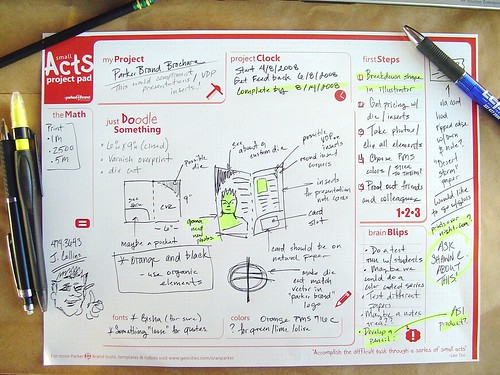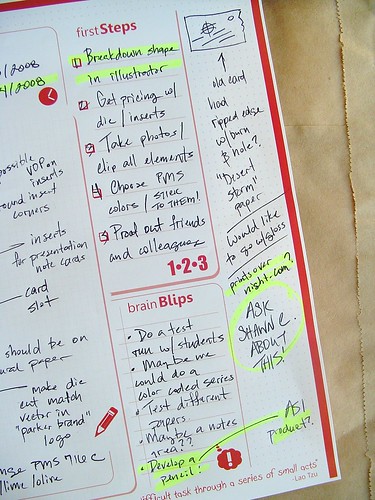
I'm always trying to figure out the best way to kick-start a project. I've tried a lot of different things over the years, but none of it seems to stick.
I've been using the same basic formula for many years now.
- I always carry a notebook and write everything down (phone numbers, meeting notes, checklists, etc.)
- I always carry a sketchbook so I can capture quick doodles, mind maps and measurements.
- I take the combination of the two and try to boil the information down so I can get started.
Sounds really easy, doesn't it? Well apparently getting started is not as easy as it sounds. What I'm finding is that the busier I get and with the increasing quantity of information that I have to process, my time from the actual project meeting or brainstorming session to action is getting longer and longer. I've got good notes, mind maps and sketches, but turning that information into usable action is getting harder and harder.
I've been struggling with the problem for a while, because it seems that it's the same story everywhere I go, all across the creative spectrum; too much information, too tight a deadline and not enough hours from sun-up to sun-down to get things done.
I'm making another attempt to solve it. Funny thing is that I've read the answer over and over again in the Tao Te Ching. "See the small as large and the few as many. Accomplish the difficult task through a series of small acts." -Lao Tzu

A series of small acts....hmmm.
That simple statement has led me to develop a project pad prototype for us folks who work in the creative industries. It's designed with one goal in mind; take your notes, sketches and mind maps and then transfer your key information to this sheet. Use that information to develop your concept quickly and identify 5 first steps toward making your project happen.
Sounded like a simple idea to me.
So I sat down and worked through a project that had been swirling around in my mind. My first step to creating this prototype was identifying the keys to my creative process after a meeting.

My Project: Give the project a name. Something memorable and simple.
Project Clock: Set a rough time line for yourself. When will you start? When do expect to have something to proof out? When would you like to be (or have to be) finished?
The Math: I'm always dealing with measurements, folds, page counts, sizes and quantities. Get your number down on paper. It doesn't matter if you have all the info just yet.
Just Doodle Something: Sketch out your ideas. Look at your sketches from your meeting. Got any ideas in there that are better than others? Capture those ideas and flesh them out a little further. Work out your folds or die cuts. Allow new ideas to form. Settle on a design path.

Colors: Pick some. I usually start with four. I use a really simple little vector tool I developed called swatch prisms. This is the easiest thing you can do. What is the vibe of the project? What emotion are you going for? Find a palette to begin with. You can always change it later.
Fonts: Pick a font or fonts. You're going to have to do this eventually anyway. Why not do it now? If you don't like it you can always pick another. Remember, you're just trying to take some quick action.
First Steps: Break it into small bites. Baby steps. I read somewhere that momentum only builds once you actually get moving. The key here isn't to figure everything out; it's just to do something, to move from idea to action. Once you have actual footprints on the project it will evolve and things will begin to come together.
Brain Blips: Let new ideas arise. You've gotten this far and the juice is probably flowing. Good ideas may start coming to you. Capture these blips as they arise. Give them a try. Who knows? They may not work on this project, but there could be one down the road that it could work on.
The Fringe: Go outside of the lines. Be organic and allow yourself room to just work out the kinks. Every idea can't be defined by a box or category. It's okay to let some things be nameless. Jot down your fringe ideas as you move through the process. That's the raw, pure stuff that comes from the creative principle deep inside. Make room for that.

What I've tried to develop here is something that compliments my creative process. I'm hoping that as I use this more and more I'll be able to make movements on my projects much quicker, avoiding that creative brain freeze that we all get from time to time.
I don't know about you folks, but my deadlines are tighter and tighter, which means that I can't afford to get bogged down. On every single project I need to come up with a plan and get moving quickly. I hope the simple formula that this project pad represents will help.
I invite you to download my project sheet and give it a test drive. Does it work for you? Are there areas that it doesn't address? Anything that you'd like to see added or revised? My hope is that it will get you from zero to action on your next project in no time.
No comments:
Post a Comment